- Products
- Email Verifier Verify emails addresses individually, in bulk or through API, with 99% accuracy
- Email Finder Find individual or bulk emails by entering the person & company name or domain
-
Form Guard Protect your forms from spam, bots, and invalid submissions with real-time email, phone, and name verification.
- Prospect SQL/MQL list building with high levels of personalization, real-time data enrichment and prospect search
- Clearout For SheetsVerify email addresses directly on Google Sheets with Clearout for sheets add-on
- ClearoutPhoneValidate phone numbers across 240+ countries in bulk, quick or real time validation Free Tools
- Disposable Email Checker
- Reverse LinkedIn Profile Lookup Tool
- Reverse Email Lookup Tool
- Email List Cleaner
- ResourceDEVELOPER
API
Clearout APIs are structured around REST and JSONWebhooks
Capture real-time events in your application workflowForm Guard
Real-time form validation to keep bad contacts out of your CRMKNOWLEDGE BASEGetting started
Sending campaigns without bounces is made simpleFAQ
Easily find answers to services, security and common questionsUSE CASESLead Generation
Learn how professionals generate quality leadsGUIDESPricingTransparent & flexible pricing to support pay-per-use or recurringEmail Verifier - Comparison
AI-powered email verification with 99%+ accuracy, real-time validation, and transparent risk scoringEmail Finder - Comparison
Pre-verified B2B email addresses with confidence scoring, find real person email, not role-based addressBLOGSEmail Verification ToolsHow To Build a Strong Sales Pipeline?View All Blogs
- Pricing
- Integrations
- Enterprise
- Login
Clearout Webhooks: Automate Workflows with Real-Time Alerts
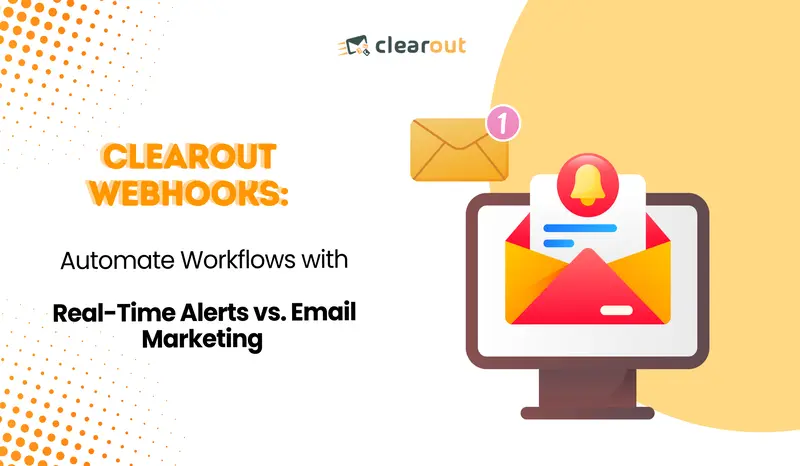
A lot of companies are losing an average of 23% of their email deliverability due to the fact that they continue to check the validation results manually.
As you refresh your dashboard or call APIs every few seconds, your competitors are already dropping campaigns to confirmed lists.
The difference?
They automated their whole working process using webhooks. The use of Webhooks changes the process of email recurrence verification by sending real-time notifications to your application.
Enough waiting, enough guessing and most importantly, no more time wastage on checking whether your verification is successful.
Let's take you through all that you should know about Clearout webhooks and how they will fasten the process of email validation.
As you refresh your dashboard or call APIs every few seconds, your competitors are already dropping campaigns to confirmed lists.
The difference?
They automated their whole working process using webhooks. The use of Webhooks changes the process of email recurrence verification by sending real-time notifications to your application.
Enough waiting, enough guessing and most importantly, no more time wastage on checking whether your verification is successful.
Let's take you through all that you should know about Clearout webhooks and how they will fasten the process of email validation.
Table Of Content
What Are Webhooks and Why Should You Care?
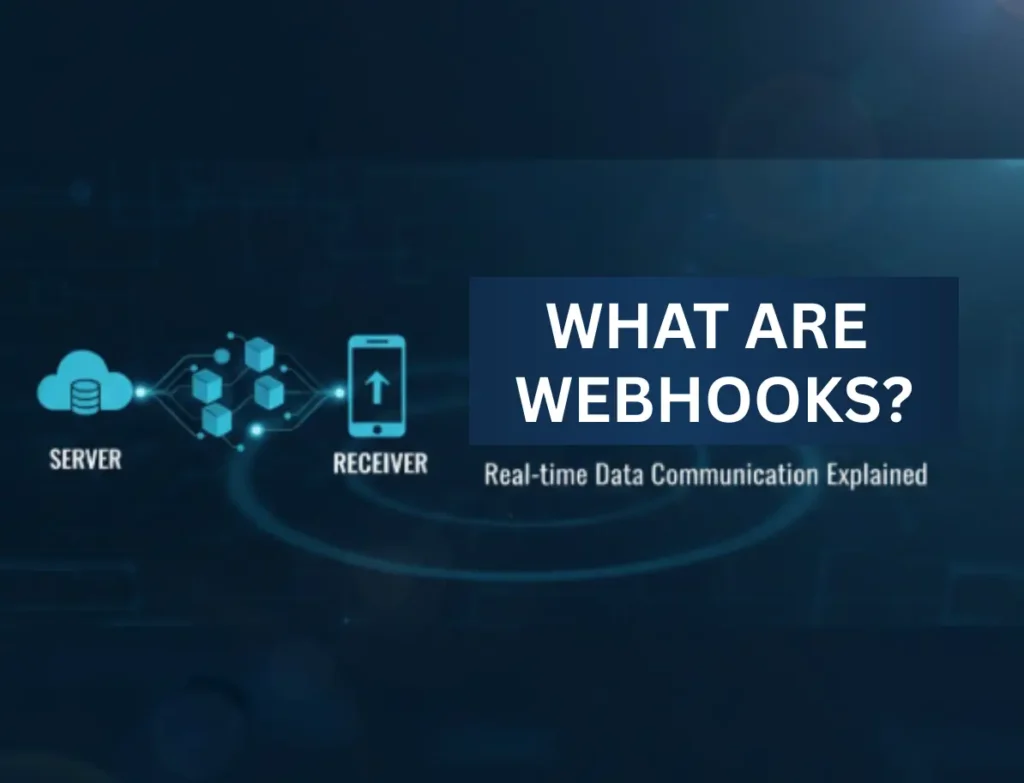
Webhooks can be described as your own notification system, which operates 24/7, with no interruptions. Rather than asking all the time, is my email verification done yet? Webhooks give you an uppercut when results are available.
It can be explained in the least complex way possible. In traditional APIs, you would be like a person who calls a restaurant to know whether the order is ready. With the web hooks, the restaurant rings you when your food is ready.
So, you conserve time and energy.
The concept behind clearout webhooks is that important events take place and an HTTP POST request is sent with a JSON payload to your endpoint URL.
These are email validation completions, email finder results and form guard triggers. This data is immediately received in your application and can be processed to suit your requirements.
Your original API call might fail or a status code you are not familiar with, but the webhook will guarantee you still have the results. Network hiccups no longer will cost you valuable data.
It can be explained in the least complex way possible. In traditional APIs, you would be like a person who calls a restaurant to know whether the order is ready. With the web hooks, the restaurant rings you when your food is ready.
So, you conserve time and energy.
The concept behind clearout webhooks is that important events take place and an HTTP POST request is sent with a JSON payload to your endpoint URL.
These are email validation completions, email finder results and form guard triggers. This data is immediately received in your application and can be processed to suit your requirements.
Your original API call might fail or a status code you are not familiar with, but the webhook will guarantee you still have the results. Network hiccups no longer will cost you valuable data.
1. The Real Cost of Not Using Webhooks
You can check verification status by polling APIs after every 5 seconds. But don't you think this is wasting time on 720 unnecessary requests per hour.
This is a waste of computation, more burden to the server and lost response time to your users.
Webhooks help to remove this inefficiency altogether. You write a single time, and Clearout does the rest.
This is a waste of computation, more burden to the server and lost response time to your users.
Webhooks help to remove this inefficiency altogether. You write a single time, and Clearout does the rest.
2. Webhooks vs APIs: What's the Difference
With APIs, you need to start all interactions. You make a request, wait till it is responded and repeat the process until you receive the information you need.
This request-response model is effective but generates unnecessary overheads.
Webhooks reverse this position. Clearout will automatically send data to your endpoint once it is configured and events happen.
You do not ask, you are just given what is important at the opportune time.
Take the case of email finder operations. In the case of no webhooks, you would poll the API until the finder finishes its search.
Automatic notifications will be received when results are ready with the email_finder.instant.completed webhook event. The saved time multiplies rapidly in hundreds or thousands of daily processes.
This request-response model is effective but generates unnecessary overheads.
Webhooks reverse this position. Clearout will automatically send data to your endpoint once it is configured and events happen.
You do not ask, you are just given what is important at the opportune time.
Take the case of email finder operations. In the case of no webhooks, you would poll the API until the finder finishes its search.
Automatic notifications will be received when results are ready with the email_finder.instant.completed webhook event. The saved time multiplies rapidly in hundreds or thousands of daily processes.
Setting Up Your First Clearout Webhook
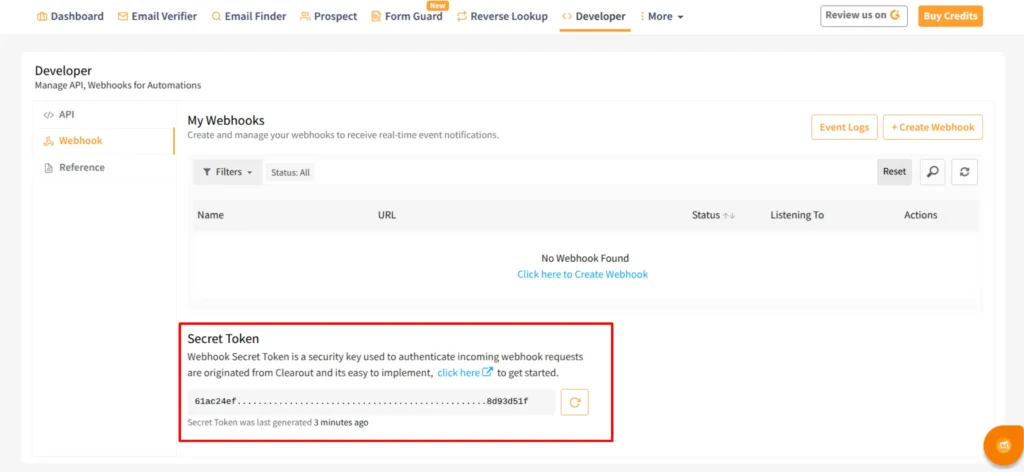
It is less than five minutes to set up Clearout webhooks. The platform gives a dashboard interface that is easy to use and manages all the technical complexity in the background.
Log in to your Clearout application, and then go to the Developers panel in the main menu. On Webhook, you should open the webhook management dashboard.
You will find a clean interface marked with any existing webhooks and the possibility to create a new one.
To open the configuration form, follow the Create Webhook button. This is where you will specify how your webhook will act and what it will be monitoring.
For more information, check: https://docs.clearout.io/webhooks/index.html
Log in to your Clearout application, and then go to the Developers panel in the main menu. On Webhook, you should open the webhook management dashboard.
You will find a clean interface marked with any existing webhooks and the possibility to create a new one.
To open the configuration form, follow the Create Webhook button. This is where you will specify how your webhook will act and what it will be monitoring.
For more information, check: https://docs.clearout.io/webhooks/index.html
1. Configuring Your Webhook Details
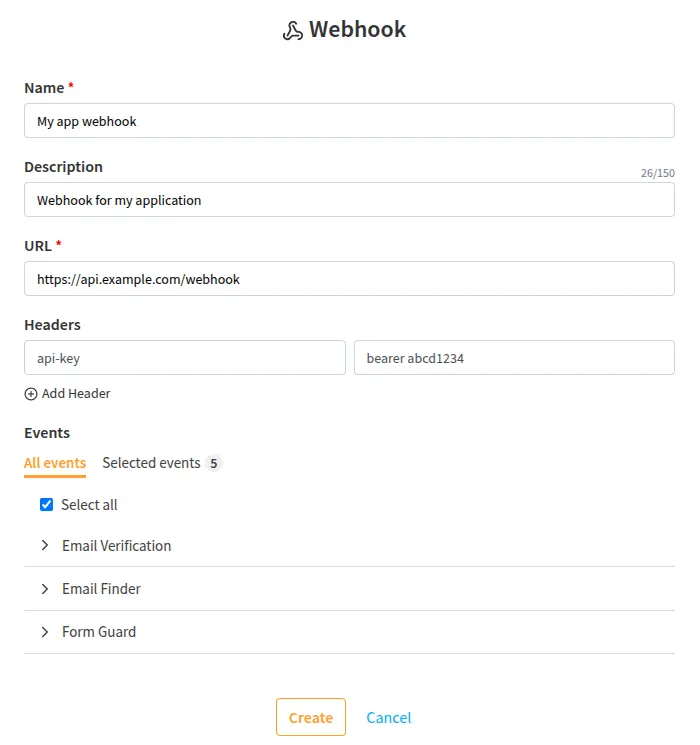
The form of configuration needs some basic information. So, name your webhook something meaningful that reminds you of some purpose.
Include an understood description of what this webhook is. You have a maximum of 150 characters, and therefore be brief. This explanation allows the team members to comprehend the purpose of the webhook without going into technicals.
The URL field is critical. Enter the HTTPS endpoint that you would like Clearout to make notifications. This should be a publicly accessible URL with support of HTTPS which is secure.
Include an understood description of what this webhook is. You have a maximum of 150 characters, and therefore be brief. This explanation allows the team members to comprehend the purpose of the webhook without going into technicals.
The URL field is critical. Enter the HTTPS endpoint that you would like Clearout to make notifications. This should be a publicly accessible URL with support of HTTPS which is secure.
2. Adding Custom Headers for Authentication
Custom headers provide you with the flexibility of managing your endpoint in regards to inbound webhooks.
- Click to add key-value pairs that Clearout will add to each webhook request.
3. Selecting the Right Events
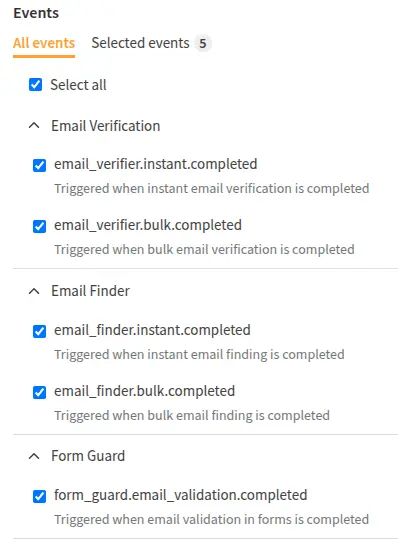
Clearout groups webhook events by service type. Each of the three email verification, email finder, and Form Guard has certain events that you can subscribe to. These are presented in the interface as a check box in groups so as to be selected easily.
It is possible to select all the events in one click or to open service sections and select specific ones. The first thing to do is to only pick the events that you need.
To get information on each event and the precise payload structure:
It is possible to select all the events in one click or to open service sections and select specific ones. The first thing to do is to only pick the events that you need.
To get information on each event and the precise payload structure:
- Refer to the Webhook Events and Payloads documentation
- Learn payload formats to write a much better processing code.
Securing Your Webhooks with Secret Tokens

Webhooks do not have a security option.
Anyone who is aware of your webhook URL would have the potential to use false requests to your endpoint. This vulnerability is avoided by the secret token system of Clearout.
The secret token is a special string that is created at the account level and that is shared with all your webhook. This token is used by Clearout to generate cryptographic signatures of each webhook request.
These signatures are validated by your endpoint to make sure that the requests are authentic by Clearout.
Anyone who is aware of your webhook URL would have the potential to use false requests to your endpoint. This vulnerability is avoided by the secret token system of Clearout.
The secret token is a special string that is created at the account level and that is shared with all your webhook. This token is used by Clearout to generate cryptographic signatures of each webhook request.
These signatures are validated by your endpoint to make sure that the requests are authentic by Clearout.
1. Generating Your First Secret Token
On the webhook dashboard:
- Scroll down to the Secret Token section.
- When you are creating a webhook the first time you will have a Generating Token button.
- Click it to make you a secret token.
- The token appears only once. Paste it and save in the settings of your application.
- In case it is lost, you need to turn the token and make all endpoints current.
- Do not put it under version control, publish it or embed it in client-side code.
2. Rotating Your Secret Token

The token rotation ensures that you are not affected in case the token is compromised.
- Tap the rotate button (circular arrow icon) which is next to the current token on the dashboard.
- Clearout generates another token and shows it immediately.
- Copy it now at once, you will never see it again.
- Before the old one expires, you can update your webhook endpoint with the new token.
Testing Webhooks Before Going Live
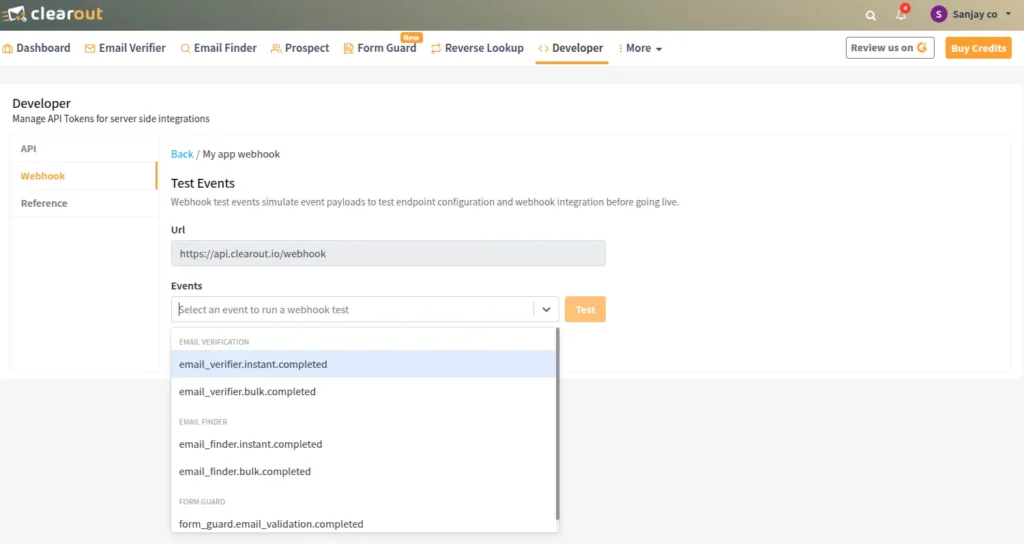
Testing eliminates calamities of production. Clearout provides in-built utilities enabling you to test your setting without live events.
- In the list of webhooks, there is a Test Events button (paper plane) on each of them. Click it and open the test interface.
- Your webhook URL is automatically inserted into the form and all the types of events are presented.
- Select an event and choose Test.
- You will be receiving a webhook on the URL you have configured along with the sample payload of the event you have selected.
- This will enable you to validate if you receive the webhook and see how the payload structure will look like.
Common Use Cases for Clearout Webhooks
Knowing practical applications assists you to make use of webhooks. We will examine situations in which they provide the greatest value.
The easiest are real time notifications. Once email validation has taken place, trigger a webhook for the event which would alert the users immediately without having to refresh the page.
Manual entries are removed by automated workflow. Set up webhooks which will update your CRM, database, or spreadsheet when the validation results come. Verified lists are made available to sales teams instantly.
The easiest are real time notifications. Once email validation has taken place, trigger a webhook for the event which would alert the users immediately without having to refresh the page.
Manual entries are removed by automated workflow. Set up webhooks which will update your CRM, database, or spreadsheet when the validation results come. Verified lists are made available to sales teams instantly.
Building a CRM Integration
A majority of companies will have email lists as part of the CRM. Webhooks are used to synchronize validation with the CRM in real time.
Upon completion of verification, Clearout sends results to your server. The server interprets the payload, derives validation statuses and modifies CRM records.
The invalid emails are classified, the risky emails are sent to review queues and the valid emails are placed in the active campaigns.
This automation operates 24-hours without human control. CRM is constantly updated with the latest validation information.
Upon completion of verification, Clearout sends results to your server. The server interprets the payload, derives validation statuses and modifies CRM records.
The invalid emails are classified, the risky emails are sent to review queues and the valid emails are placed in the active campaigns.
This automation operates 24-hours without human control. CRM is constantly updated with the latest validation information.
Managing Your Webhooks
Active management makes webhooks consistent in the long term. The dashboard provided by Clearout has the means of uninterrupted monitoring and maintenance.
Four Essential Webhook Actions
Every webhook contains four action buttons:
- View Event Logs: It displays a detailed history of deliveries, the response code, and the payload (JSON) as well as timestamps. Check this information to debug bugs or verify successful integrations.
- Test Events: It transmits a test payload to test.
- Edit Webhook: Opens the settings form in which you can change names, description, URLs, custom headers, and subscriptions to events.
- Delete Webhook: Permanent deletion of the configuration. Clearout requests confirmation before deletion.
Wrapping Up
Clearout webhooks will change email verification into an effective, automated, and time-saving system, as compared to a manual activity. You will know how to configure, protect, test, and control webhooks that send real-time pings to your applications.
Only one of the most vital things you require is a webhook. Check it with attention to detail when you are still in dev. Monitor the event logs and adjust the settings to suit your needs.
Your next steps are easy. Go to the webhook dashboard in your Clearout account and use it to create your first webhook. Select the ones, which are most significant in your workflow. Test the whole thing out.
Only one of the most vital things you require is a webhook. Check it with attention to detail when you are still in dev. Monitor the event logs and adjust the settings to suit your needs.
Your next steps are easy. Go to the webhook dashboard in your Clearout account and use it to create your first webhook. Select the ones, which are most significant in your workflow. Test the whole thing out.
Need to automate that workflow?
FAQs
1. What will occur in case of unavailability of my webhook endpoint temporarily?
Clearout gives smart retry logic on failure of delivery. The system will reschedule again with time gaps that increase to fill short term failures. This keeps you alive even though your destination is temporarily offline.
2. Can I use the same webhook URL with several clearout webhooks?
Yes. The event types field of each payload is all you need to have your code read the varying events properly.
3. Will Webhook events use my Clearout account credits?
Webhook events are not charged. You pay only the service operations actually done to the system such as email verification or finder operations that cause the webhooks.
4. How do I ensure that webhook requests are genuine Clearout?
Clearout signatures each request with your secret token. At the end, your endpoint must authenticate such signatures. That proves the request was issued by Clearout and has not been compromised to issue an attack.
Recent Posts
27 Nov 2025
Clearout Recognized In Forbes India DGEMS Select 200 | 2025
Clearout featured in Forbes India DGEMS Select 200 (2025 Cohort) for its innovative & scalable solut ...
21 Nov 2025
9 Hidden Bot Patterns Behind Modern Form Attacks
Wondering how bots still slip through your forms? Explore 9 hidden bot patterns behind modern form a ...
19 Nov 2025
10 Proven CRM Migration Best Practices for 2026
Explore the best practices of CRM migration in 2026 and learn how to audit data, map fields, cleanse ...
19 Nov 2025
How Syntax, Domain, and SMTP Email Validation Checks Work
Explore how syntax, domain, and SMTP email validation checks work and how they help identify formatt ...
18 Nov 2025
How to Find Business Email Addresses the Legal & Ethical Way
Learn legal and ethical considerations when finding business email addresses. Stay GDPR-compliant, a ...
Clearout's
Form Guard
Validate email, phone & name on any forms!
- Real signups only
- Verified emails
- Valid phone numbers
- No fake names
- Cleaner CRM
- No devs needed
Email Verification, Email Finding Form Guard & Prospecting Service
Expand Your Reach By Finding & Verifying Ideal Prospects.

